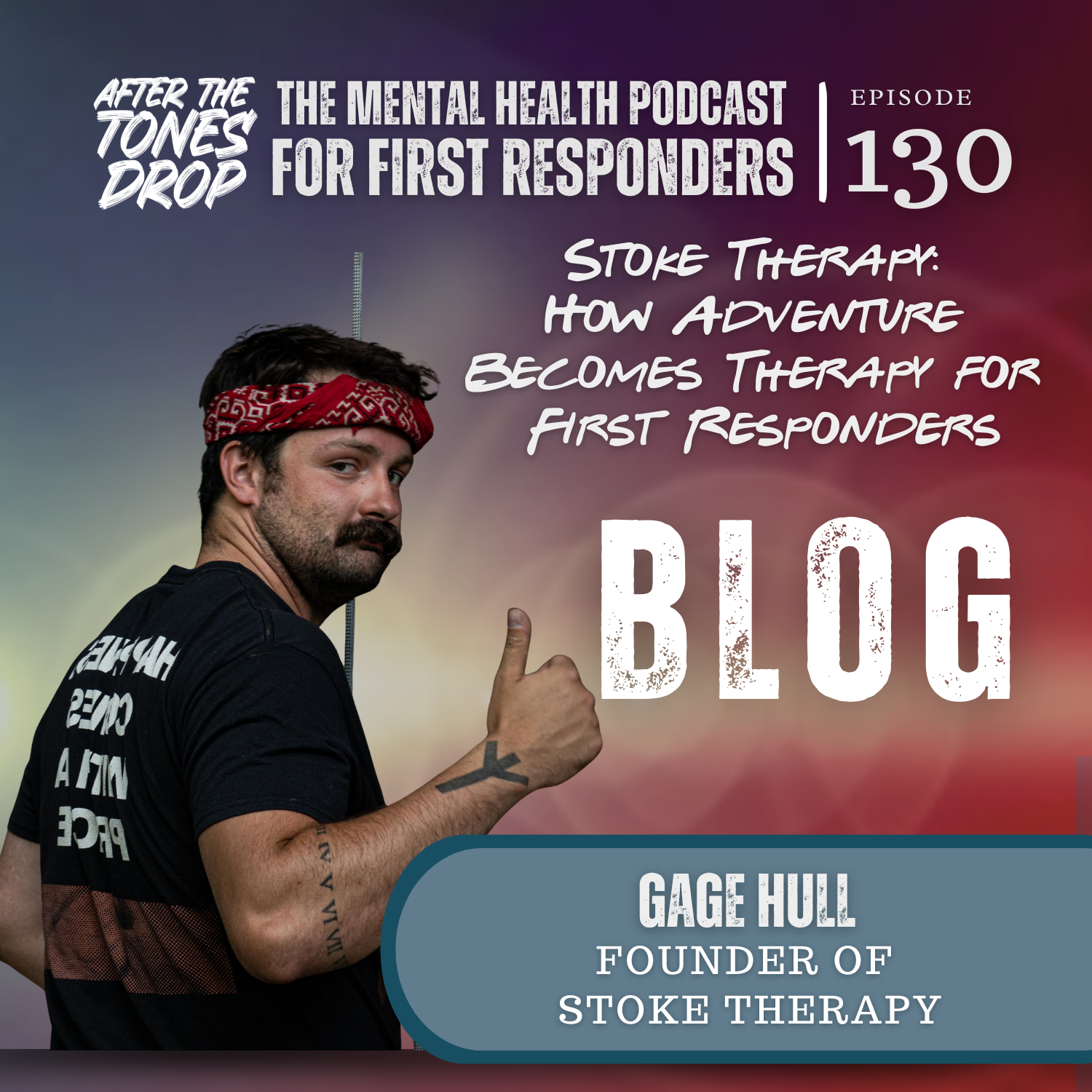Finding Stoke: How Adventure Becomes Therapy for First Responders

What if the most effective form of therapy doesn’t happen on a couch—but on a surfboard, a mountain, or beneath the surface of the sea?
For firefighter, EMT, and Army veteran Gage Hall, healing didn’t begin in a quiet office. It began in motion—with saltwater in his hair and laughter echoing across the waves.
🎧 Listen to Episode 130: “Out of the Warzone and Into the Water”
👉https://www.afterthetonesdrop.co/gage-hull
The Backstory: From Warzone to Wilderness
At just 17, Gage enlisted in the Army and served as a combat photographer embedded with special operations teams. He spent his early adult life documenting war, camera in hand, adrenaline high, constantly surrounded by chaos. But when the noise stopped, the silence became unbearable.
Coming home wasn’t the relief he expected. Like many veterans and first responders, Gage found himself carrying invisible wounds—anxiety, depression, and post-traumatic stress—and struggling to find meaning beyond the uniform.
He tried traditional therapy, but something was missing. “It’s not that therapy didn’t work,” Gage says. “It just didn’t feel like it was made for me.”
So he went back to what had always brought him peace: movement, challenge, and the outdoors.
That’s where Stoke Therapy was born—a program that merges adventure, connection, and purpose to help others like him rediscover who they are beyond the job.
What is Stoke Therapy?
Stoke Therapy is a nonprofit organization that helps first responders, veterans, and service members heal through adventure-based therapy.
From rock climbing and surfing to scuba diving and hiking, every Stoke experience is built around one central truth: you can’t think your way out of trauma—you have to move through it.
The goal isn’t just physical challenge—it’s emotional restoration. Gage and his team of trauma-informed coaches create a space where participants can be vulnerable, laugh, and reconnect with joy.
“The biggest emotion I’m trying to get people to experience with Stoke is joy,” Gage says. “When they see someone like me—someone with their same background—take off the armor, relax, and just exist, that’s when real healing starts.”
How is Stoke Therapy Different from Traditional Therapy?
It’s Experiential, Not Just Talk
In traditional therapy, you sit in a chair and talk about feelings. In Stoke Therapy, you climb a rock face, paddle through waves, or dive underwater—and those experiences become the conversation.
These activities engage the nervous system, allowing participants to process emotions physically. The natural endorphins and flow states that occur during adventure activities lower stress hormones, increase dopamine, and create a sense of accomplishment—often faster than talk therapy alone.
It’s About Community, Not Isolation
Many first responders and veterans struggle to connect with civilians who can’t relate to their experiences. Stoke Therapy builds peer-based healing environments—small groups led by people who’ve “been there.”
The shared laughter, teamwork, and trust formed on a mountain or in the ocean become powerful antidotes to isolation.
“That community piece is the biggest thing that’s messing up this population,” Gage explains. “It’s the loneliness, the isolation. Stoke gives them connection again.”
It Prioritizes Joy and Play
Healing doesn’t have to be heavy. Stoke’s activities are designed to bring back fun, curiosity, and presence—the very things trauma takes away.
Whether it’s singing off-key on a paddleboard or joking at the top of a climb, participants relearn how to feel safe in joy. This “joy therapy” retrains the brain to associate life with pleasure instead of danger, helping rewire trauma responses.
It’s Holistic and Science-Backed
Every element of Stoke Therapy leverages what science already knows about healing:
-
Nature exposure lowers cortisol and blood pressure.
-
Physical movement improves mood and brain plasticity.
-
Social connection releases oxytocin and reduces loneliness.
-
Novelty and challenge build confidence and cognitive flexibility.
The result is a full-body reset—a therapy that works through movement, connection, and emotion all at once.
It Removes the Stigma
Stoke Therapy meets people where they are. You don’t have to say you’re going to therapy—you can just say, “I’m going surfing.” That simple reframe makes it easier for first responders, who often resist help, to engage without fear of judgment.
Why Stoke and Traditional Therapy Work Better Together
While adventure therapy is powerful, Gage emphasizes that it’s not a replacement for traditional therapy—it’s a complement.
By combining physical adventure with evidence-based modalities like Cognitive Behavioral Therapy (CBT) or Dialectical Behavior Therapy (DBT), participants can process trauma both in body and mind.
“You don’t have to do mindfulness exercises—it’s right here,” Gage says. “You’re in the moment, fully. Add CBT or DBT to that, and you can’t pack more therapeutic benefit into one experience.”
The Bigger Picture: A Culture Shift in Mental Health
Stoke Therapy isn’t just helping individuals—it’s helping shift an entire culture.
For too long, first responders and veterans have been told to “suck it up.” Now, voices like Gage’s are proving that vulnerability and strength can coexist. That getting help doesn’t mean you’re weak—it means you’re human.
As more organizations integrate adventure-based healing into wellness programs, the message is spreading: mental health support can be dynamic, empowering, and even fun.
The Takeaway
You don’t have to be broken to work on yourself.
You don’t have to sit still to heal.
And you don’t have to do it alone.
Whether you’re on a board, a bike, or a trail—healing starts when you move toward it.
🎧 Listen to Episode 130: “Out of the Warzone and Into the Water”
👉https://www.afterthetonesdrop.co/gage-hull


